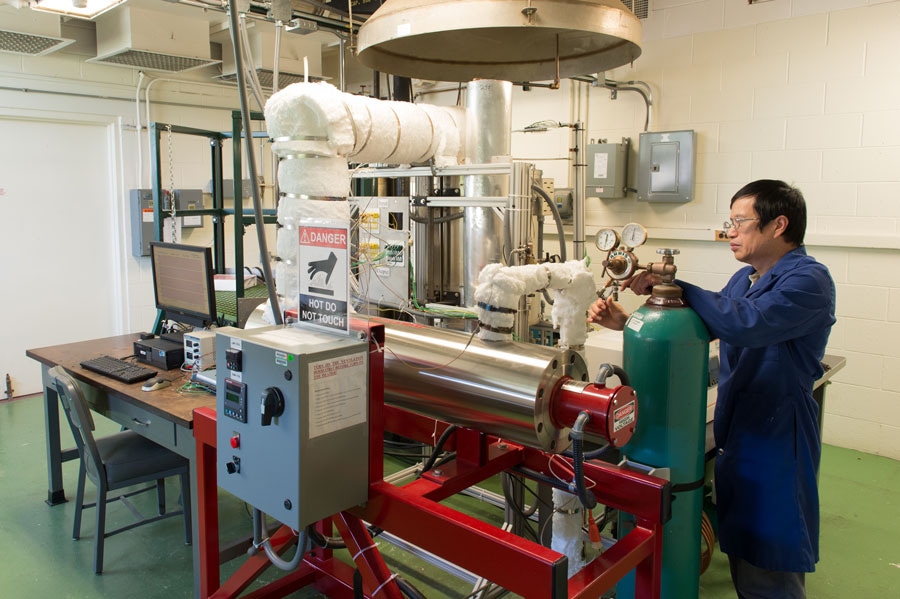Sep 13 2016
Energy storage is crucial for taking full advantage of solar power, which otherwise suffers interruptions from cloudy skies and nightfall. In the past few years, concentrating solar power plants have begun producing additional electricity at night and during peak demand periods by using stored heat energy to propel a steam turbine.
 Argonne National Laboratory mechanical engineer Wenhua Yu prepares to test a prototype thermal energy storage system developed at Argonne that will charge and discharge 20 times faster than current high-efficiency latent heat thermal energy storage systems. Testing validates the amount of thermal energy that can be stored and how efficiently it can be recovered for concentrated solar power and other potential applications. Credit: Argonne National Laboratory
Argonne National Laboratory mechanical engineer Wenhua Yu prepares to test a prototype thermal energy storage system developed at Argonne that will charge and discharge 20 times faster than current high-efficiency latent heat thermal energy storage systems. Testing validates the amount of thermal energy that can be stored and how efficiently it can be recovered for concentrated solar power and other potential applications. Credit: Argonne National Laboratory
Current thermal energy storage systems rely on materials that store less energy per kilogram, requiring more material at a greater cost to meet energy storage requirements.
Now, researchers at the U.S. Department of Energy’s (DOE’s) Argonne National Laboratory have designed an inexpensive thermal energy storage system that will be significantly smaller and perform more than 20 times better than current thermal systems.
With funding from DOE’s SunShot Initiative, the Argonne team is building a pilot-scale prototype of their high-efficiency latent heat thermal energy storage system (LHTES) for testing. The SunShot Initiative is a national collaborative effort to make unsubsidized solar energy cost-competitive with other forms of electricity production by 2020.
Argonne’s thermal energy storage system relies on a “phase-change” material that melts as it stores thermal energy and releases energy as it re-freezes — similar to the charge-discharge cycle in a battery.
Inexpensive salts like rock salt (sodium chloride) can be used as phase-change materials, but their use in existing thermal storage systems is limited because of the poor thermal conductivity of the salts.
However, the Argonne LHTES system drastically improves the conductivity of these salts by integrating them with a high-conductivity graphite foam. This combination reduces the overall amount of material needed to build the system and its cost, while making the thermal energy transfer significantly more efficient and still providing up to 8 to 12 hours of energy storage — a typical night of storage for a concentrating solar power plant.
“Phase-change materials tend to have low conductivity but meet the heat energy storage requirements,” said Dileep Singh, leader of Argonne’s Thermal-Mechanical Technologies group. “High-conductivity graphite foam meets the conductivity requirements, so we thought: why not combine the two?”
The porous graphite foam traps the salts in pores, facilitating rapid melting and freezing. The team demonstrated that this rapid phase change holds up over time. After building and testing an initial prototype about the size of a blender, the team is now scaling up the prototype size by 50 times.
Although still smaller than a full-scale power plant system, the pilot-scale modular system will be tested this fall and could expand on applications, such as providing back-up power on a microgrid or storing waste heat from another energy source. The pilot system will also further improve 3-D thermal modeling used for estimating performance and planning the design of a full-scale system.
“We are looking at developing the full-scale power plant system as a modular system, and the pilot-scale system we are building this year can actually be used as one module within a full-scale system that is made of many modules stacked or organized together,” said Argonne mechanical engineer Wenhua Yu. “Therefore, the performance characteristics we will measure from testing the pilot can directly reflect those of a power plant system.”
The full-scale design is expected to meet the needs of current power plants that operate steam turbines at about 450 to 600 degrees Celsius (850-1100 degrees Fahrenheit) using magnesium chloride as the storage medium. When advanced supercritical carbon dioxide turbines — which are more efficient than steam turbines but operate at a hotter 700 degrees Celsius (1,300 degrees Fahrenheit) — come online, the same design can be used with sodium chloride.
This work is supported by the DOE SunShot Initiative.
The SunShot Initiative is a collaborative national effort that aggressively drives innovation to make solar energy fully cost-competitive with traditional energy sources before the end of the decade. Through SunShot, the DOE supports efforts by private companies, universities, and national laboratories to drive down the cost of solar electricity to $0.06 per kilowatt-hour. Learn more at energy.gov/sunshot.